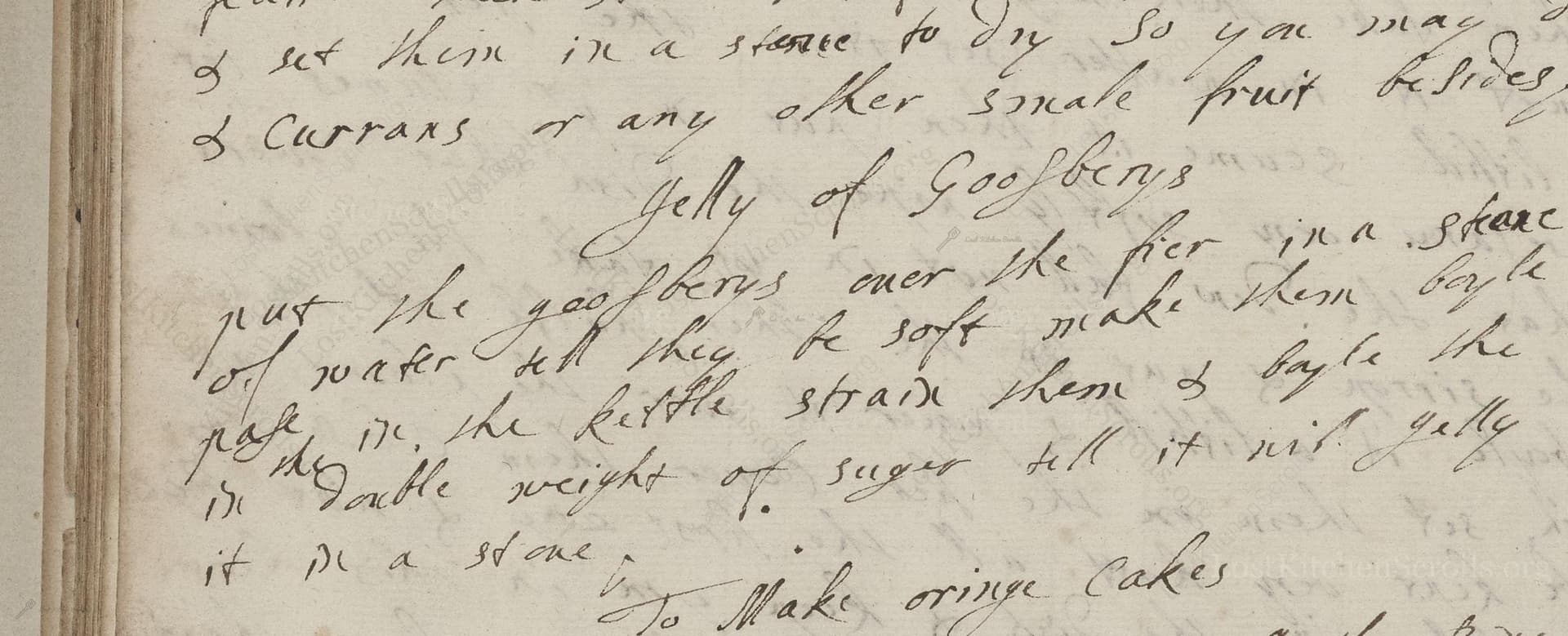Jelly Of Goosberys
From the treasured pages of Receipts in cookery and medicine 1700
Unknown Author

Jelly Of Goosberys
"put the goosberys over the fier in a skare in a kettle of water till they be soft make them boyle a great pase in the kettle straine them & boyle the Cleare Juice in the duble weight of suger till it will Jelly then put it in a stove."
Note on the Original Text
The recipe is written in the straightforward, often fragmentary style of early 18th-century English cookery books. Spelling was not standardised ('goosberys' for gooseberries, 'fier' for fire, 'kettle' for pot), and punctuation is minimal. Instructions assume familiarity with kitchen processes—quantities and timings are vague, reflecting practices of working by feel and experience rather than precise measurement.

Title
Receipts in cookery and medicine 1700 (1700)
You can also click the book image above to peruse the original tome
Writer
Unknown
Era
1700
Publisher
Unknown
Background
Step into the kitchen of the early 18th century, where this charming culinary manuscript tempts tastebuds with recipes and secrets from a bygone era. A delicious journey for both the curious cook and the history lover.
Kindly made available by
Folger Shakespeare Library
This recipe comes from an English manuscript dating to around 1700, when home preservation of fruits was common practice, especially to make delicious jellies and jams before the invention of commercial pectin. Gooseberries were widely grown in kitchen gardens and prized both for their tart flavour and gelling properties. Such recipes allowed cooks to preserve the fleeting bounty of summer for enjoyment throughout the year.

Historically, cooks would have used a heavy iron or copper kettle suspended over an open hearth. To strain the fruit, a coarse cloth or linen set over a bowl (sometimes called a jelly bag) was standard. The finished jelly would be put in earthenware pots or glass jars, and set in a warm place such as a drying oven or a hearth-side stove to finish setting.
Prep Time
10 mins
Cook Time
45 mins
Servings
60
We've done our best to adapt this historical recipe for modern kitchens, but some details may still need refinement. We warmly welcome feedback from fellow cooks and culinary historians — your insights support the entire community!
Ingredients
- 2.2 lbs fresh gooseberries (or substitute with green currants if gooseberries unavailable)
- water (just enough to barely cover the gooseberries, approx. 2 cups)
- 4.4 lbs granulated sugar
Instructions
- To make Gooseberry Jelly, take fresh gooseberries and place them in a saucepan, covering them with water.
- Heat gently and simmer the berries until they are soft.
- Strain the mixture through a fine sieve or muslin, pressing to extract the clear juice.
- Weigh the juice, then add double its weight in granulated sugar.
- Return the juice and sugar to a clean saucepan and bring to a rapid boil, stirring until the sugar dissolves.
- Boil quickly until the mixture reaches a jelly consistency (it should set on a cold plate).
- Pour the jelly into sterilised jars and seal while hot.
Estimated Calories
60 per serving
Cooking Estimates
It takes about 10 minutes to prepare the gooseberries and workspace. Cooking the fruit and boiling the jelly takes around 45 minutes. This recipe makes about 6 jars and each serving (about 1 tablespoon) is roughly 60 calories.
As noted above, we have made our best effort to translate and adapt this historical recipe for modern kitchens, taking into account ingredients nowadays, cooking techniques, measurements, and so on. However, historical recipes often contain assumptions that require interpretation.
We'd love for anyone to help improve these adaptations. Community contributions are highly welcome. If you have suggestions, corrections, or cooking tips based on your experience with this recipe, please share them below.
Join the Discussion
Rate This Recipe
Dietary Preference
Main Ingredients
Culinary Technique

Den Bockfisch In Einer Fleisch Suppen Zu Kochen
This recipe hails from a German manuscript cookbook compiled in 1696, a time whe...

Die Grieß Nudlen Zumachen
This recipe comes from a rather mysterious manuscript cookbook, penned anonymous...

Ein Boudain
This recipe comes from an anonymous German-language manuscript cookbook from 169...

Ein Gesaltzen Citroni
This recipe, dating from 1696, comes from an extensive anonymous German cookbook...
Browse our complete collection of time-honored recipes



